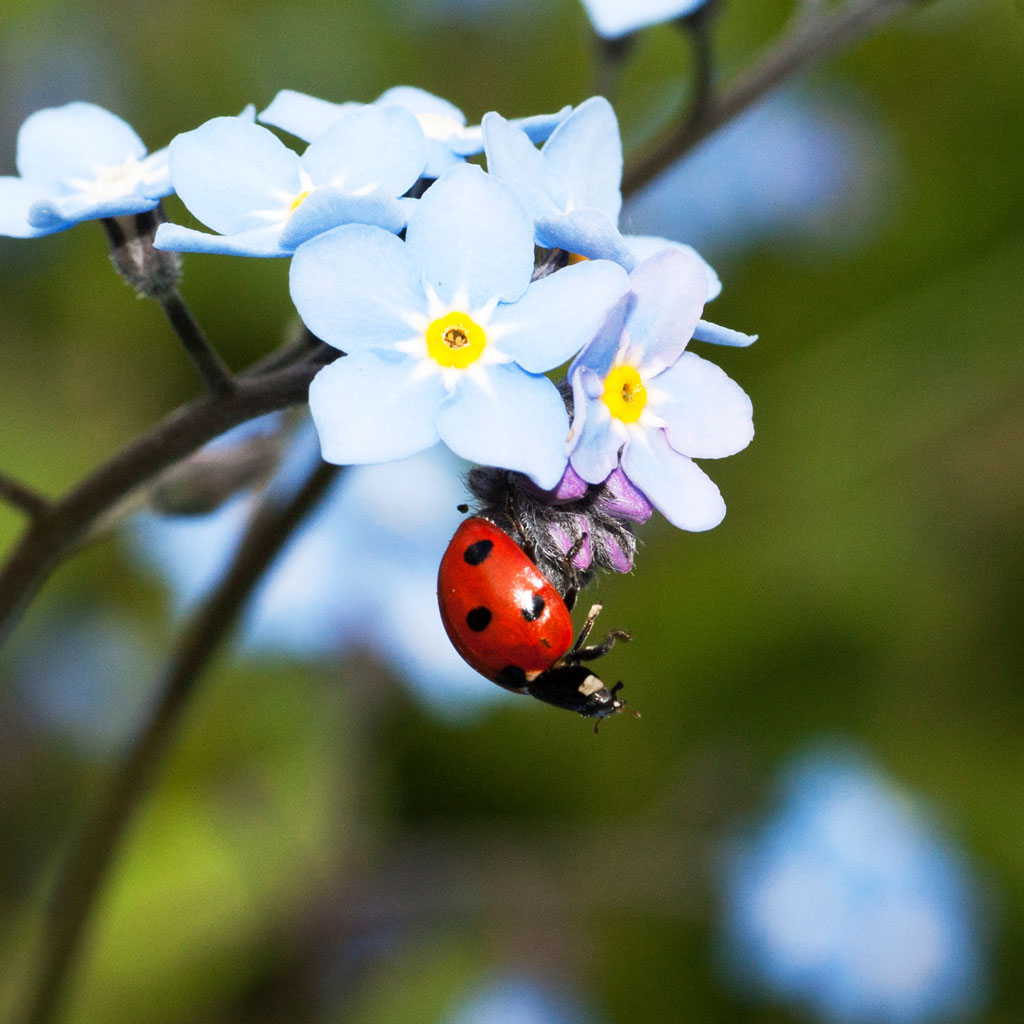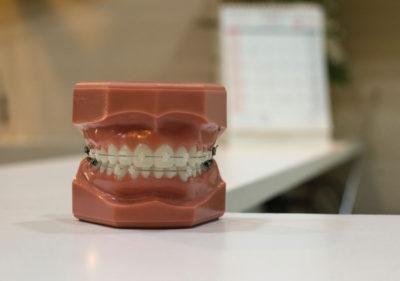
Virginia Marshall
LADIES.
I wonder at the little dead lady on my carpet. I found her as I was picking up tissues from the floor of my bedroom, underneath the bed, lying on her back like a lentil. I had an urge to put her in my mouth, but then I remembered that she must be the same one that was crawling around my room in September. I had identified with the little lady, indecisively flitting around the room, landing on the white plastic blinds, walking along there for a while until she came to what she thought was the end of the earth, and beyond that the buttery yellow fabric of my curtains: heaven, for a bug.
Ladybugs are a godsend—they were given to the poor peasants of Europe in the Middle Ages who prayed to the Virgin Mary to save their crops from a tiny, voracious pestilence. It is true that occasionally her leg joints sweat blood, and poisonous chemicals make up nearly a quarter of her weight. Yet, to humans, a lady is adorable. It is something about her coloring, and the perfect polka dots. She is made into plush toys and children’s backpacks. She brings good luck. Ladies titter: Can you imagine a child with a stuffed animal spider? Or a fruit fly? Ladies cover their voracious mouths with their segmented feet when they laugh. She is so inoffensive (silent, beneficial), she’s not really an insect at all. In Romania they call her the pope’s ox; in Lithuania she is God’s little cow; in England she is ladybird; in America she has been stripped right down to bug.
Ladies are carnivores. Protruding from the front of their heads are two enormous teeth, the mandibles, which cut and chew. Around their mouths are small fingers that grab at the chewed food and coax it into their mouths. Ladies can eat about fifty aphids a day. They are ravenous from the beginning. When they hatch out of their eggs they are orange and black blobs, spiny and gross. Without spots, the bulbous little things are directionless eating machines. Infant ladies will even eat their sisters for the sake of growing, one day, into big, strong, spotted beetles.
Ladies mate in a fashion that is deemed “highly promiscuous.” Out among the lush pines, they will procreate, the female lady holding onto the sperm of several different male ladies at once, mating ten times more than what is scientifically necessary to ensure offspring survival. Many paragraphs in entomological encyclopedias are devoted to musing on the duration of the ladybug’s lovemaking: it can last up to two hours per couple, much, much too indulgent for a pretty worker bug, the pale entomologists say. Ladies even contract STDs, which further validates the scientists’ righteousness. Cluck, cluck, cluck, the self-satisfied tut. If she would just keep her skirt down, her many legs crossed, she wouldn’t have done herself in.
There are over five thousand kinds of ladies. Some have seven spots, some nine or even twenty, and some are spotless. It was the nine-spotted lady that New York state decided to name their state insect in 1989. Several years later, she was declared gone, departed from the state. When scientists failed to find any living nine-spotted ladies, they hesitated; they feared she had gone extinct. Their theory was that either the invasion of the seven-spotted clan, brought from Europe to the states in the 1950s to gorge on aphids, or the introduction of the Asian lady beetle, released in droves in the ’80s by the US government in order to save the crops (organically! pesticide-weary politicians sputtered) and save the people, had out-eaten the native nine-spotters. Human folly, the classic blundering of bureaucracies, had perhaps killed her. In embarrassment, a bill was proposed to change the state insect. How about a nice pink-spotted ladybug instead? The bill failed. Five years later, in July, a nine-spotted lady was captured (phew) on a farm in Long Island, escaping the hot summer sun among the leafy carrot plants. (She also enjoyed zinnias.) New York abandoned plans to change their state insect, now that there was at least one still living. What luck.
The words “Lucky You” are written on the inside of my crotch zipper, plain for all to see—all, which is just me, the only person I let unzip my Lucky brand jeans these days. “Lucky you,” I will say, as I look out of the bathroom window at the parking lot and the factory that wails four times a day. Why does it wail and for whom? Truthfully, I was charmed by my solitary lady, the one I found in my house. She was checking out my room as if to see where I keep my makeup, my underwear, other practical things. Alone, she was harmless. Alone, she was like me: wandering, waiting, not getting in anyone’s way.
◊
Last winter, Grandma got lost in the house. She came wandering into the room where I had been napping. She was looking for the bathroom and couldn’t find her own bedroom or the bathroom, even though that’s where I had left her half an hour before. So, I showed her to the bathroom and tried not to doze off, thinking to catch her when she came out and walk her back to the room where she was staying. After a while I couldn’t hear anything. I knocked on the door; no answer. She wasn’t inside, must have gone out the bathroom’s other door. I walked around the house, calling for her. Could she have wandered into the street? The pool in the backyard could look like solid ground to a grandma. I walked through the living room, the kitchen, out into the garage house, peered into Grandma’s room and came back, calling her name, a bit louder each time. I found her, finally, sitting on my cousin’s bed with her feet in their sheer black nylons propped up on the bed. She hadn’t heard my voice, but finding herself lost, she had decided to rest there until someone came for her. “I thought you would find me,” she said when I asked what had happened.
I walked her back through the living room. “What are the black things on the floor?” she asked. I told her they were part of the wood. “I thought they might be cat droppings,” she said, stepping around each spot carefully. In the kitchen, she said, “Oh yes, I’ve been here before.” Her eyes were bright green and milky. Walking out of the house and into the garage house, she said, “Now, this is new, we haven’t been here,” though that is where she had been before she wandered off. I showed her back to her room. “Oh, this is lovely, I didn’t know this was here.”
In the Midwest, where I live now, ladies flounce into homes, walk right between the cracks in doors. They come as families, parties, coworkers, friends and set about finding a good temperature for sleep. “Aw,” humans say when they see one or two ladies marching in like saints. “You can stay a while. My home is your home.” Ladies will check out the bathtub, admire the porcelain in an old cupboard. They love a good photograph and picture frames are even better, so sleek and straight, like a good pine. They wander; their heads are too little to get the full map of the house, so each time they walk up and down and up and down the legs of the desk, it is new and wonderful once more.
But as soon as there’s a crowd of ladies, numbers above five or six, they become pests. I have heard of this happening, have seen evidence of it online. The main damage is discomfort, says one website, describing a family that found swarms of ladies congregating in their attic. Together, they are threatening. Togetherness accentuates their many crawling legs, their segmented heads, and if they get a chance to crawl on your arm hairs, they’ll give you chills.
When ladies march indoors, it’s the vacuum for them or the balled-up paper towel that, when it brushes them, makes the ladies bleed reflexively. Not red blood, but a toxic orange that leaves stains on walls. And oh, the stink of it, when they bleed: like nuts, green pepper, potato and mold. The lady has irreversibly—maliciously, some might say—marked her presence in a space not made for her kind, no matter that the bleeding is natural, no fault of her own. “You need to leave now,” humans will say. “You’ve really gone too far.” Once there is an element of disgust, everything else is easier. Take away their personable noms de plume, their cute polka-dotted coveralls, and it’s easier to close the door in their faces.
Once ladies have reached young adulthood, they enter a torpor so deep they appear dead. They are scheduled to awake come spring and unfurl their ingenious wings to test their complicated origami. Up in the mountains, ladies hibernate in colonies, piled on top of each other by the tens of thousands for warmth. They are in their imaginal stage, young adults sleeping for months, perhaps dreaming, outer casings more orange than red, bodies tender.
Every year in California, hordes of ladies—the two-spotted, the seven-spotted, the eleven-, thirteen-, and fourteen-spotted, the Australian, the Asian, the transverse, the twice-stabbed—are captured in their sleep. Gloved hands collect the still-snoozing ladies, shovel them into buckets and bags, some still clinging to pine needles like security blankets or eerie, elongated teddy bears. A ladybug poacher can earn one or two thousand dollars for a day’s work, selling the ladies to organic pest control companies who will divide the colony further into individual Tupperware with tiny holes on top and instructions for refrigeration. Torpor can be extended two to three months by keeping them in the fridge, next to the cheese, spraying them with water to keep them hydrated through the long, fake winter.
On Amazon, you can buy 1,500 ladybugs in a mesh pouch for $7.50, and an organic pest control website sells them by the gallon, about 70,000 ladybugs at a deal of $150.00, or by the quart, for $43.00. They come in their drowsy imaginal stage and when warmed to outdoor spring temps will mate and lay like good citizens, their tubular larvae children consuming and consuming like the good Lord taught them.
Every year, a class of Minnesotan third graders is given bags of captured ladybugs to release in the Mall of America, for Earth Day. Seventy-five thousand ladybugs crawl over the leaves and hair and hands of plants and children. The kiddos shudder and squirm, whimpering like the toddlers they used to be. Cameramen follow them, asking questions. The kids flick their eyes from side to side, Can I say they’re gross? they think. One girl has a bit of a spasm, trying to get her last ladybug out of a plastic pail with a little shovel, shaking her hand too vigorously, barely managing to hold back a moan. Another boy shakes his gloved, lady-covered hand as if it is no longer part of his body, trying to rid himself of the final few ladies. In the background of the announcer’s jaunty report—They’re organic! Saving the plants from pests! Saving the shoppers! Saving capitalism!—kids are squealing.
On the coast of England in 1976, ladies made themselves into a plague. There were millions of them, and they descended like locusts. They crawled into open mouths; they piled themselves four ladies deep onto the sides of barns. In the swimming pools, during that hot seaside summer, ladies lay an inch thick between the abandoned floaties and pool noodles. Hungry, and drawn to the sweat of people, they attacked, latching onto skirts and braids and then nibbling when they reached flesh. (They lost interest, once they tasted our sour skin.) Perhaps it was the heat or the drought, or perhaps it was the excess grain grown that year. Whatever the reason, ladies dominated and people fled, abandoning their vacations early, zooming out of town with the kids in the back seat mourning the ice cream cones they couldn’t eat because the ladies beat them to it, slipping and slurping with glee.
◊
I have seen pictures of these swarms and felt my skin crawl. Even the poaching of them makes my stomach queasy. Though I love little ladies when they crawl alone, or smack distractedly into my bare shoulders in the summer months, ladies in crowds are suddenly not so pretty, not so human when they are gathered like this, like vermin, all individuality lost. I, too, am disgusted.
“Ew, so gross!” read the message some awful girl in high school sent to me years ago, and a link to a video, which I clicked. It was footage from the redhead convention in the Netherlands, where thousands of red-headed people, mostly women (ladies like to group), gathered for the sake of being a sight to see. A revulsion at myself, at the swarming crowd of women with flames on their heads, grew inside me. I did not like to see myself represented en masse. Gathered like that, the women were exaggerations of me, Ginger upon Ginger upon Ginger. We were making a spectacle of ourselves. Shh shh shut up.
“Haha,” I sent back. Did the awful girl want me to laugh? I wondered what part of this was funny. I watched the ladies in the video laughing with each other, holding their hands up and yelling. Why do they wail, and for whom?
What is a lady? A lady is a person who eats other ladies in order to grow; frightening (powerful) when she is with her kind; a bug whose power is only in her head; a pest programmed to group, to make walls around her people, to divide among her own kind (the two-spotted, the seven-spotted, the eleven-, thirteen-, and fourteen-spotted, the Australian, the Asian, the transverse, the twice-stabbed). I’ll bet you never knew that ladies are cannibals. I’ll bet their prettiness distracted you.
I know the little lady on my carpet crawled in as soon as she felt the chill coming, to save her skin. She had led a life of consumption, of swarming and grabbing what warmth she could get when the wind picked up. This lady escaped the swarm, and I admire her for it. Perhaps she did not want to be with sisters who might eat her, or perhaps she did not look the part. Perhaps she saw through. I let her stay on my carpet, belly up, for a few days. Then when I was cleaning, I scooped her into the trash with the tissues. A dead lady is no use to me. It was only later, in a moment of clarity, that I realized I had no way of knowing if she really was dead. She could have just been sleeping, frozen in her torpor state, bound by biology to stay. I checked the chat groups online, and they all said to wait, be patient, she may yet awake and fly off.
I have taken her out of the trash. We’ll see, I suppose; I’m still waiting. If she does wake up, when the warm weather comes, I know what she’ll do. I know her like I know myself. Ladies have agendas of their own. You can try to put her to work in your garden. You can try to make her stay, spray her with Coca-Cola and water to glue her wings shut so she cannot fly to another garden, only walk down the green stems eating critters on the way. She will be tethered for a little while, just until the sugar melts and she’s eaten a few aphids, enough to get her blood flowing and wings stretching and then (oh, then), she will split apart her back, unfold those too-big wings, and go.
 Virginia Marshall is a writer and radio producer. Her work can be read and/or heard in The Harvard Review, Atlas Obscura, The Millions, Brevity, and on WBUR, Boston’s NPR news station.
Virginia Marshall is a writer and radio producer. Her work can be read and/or heard in The Harvard Review, Atlas Obscura, The Millions, Brevity, and on WBUR, Boston’s NPR news station.
Image credit: Janice Gill on Unsplash
Read more from Cleaver Magazine’s Issue #23.



